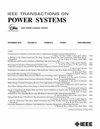网络化微电网模式无缝切换的分布式经济控制
IF 7.2
1区 工程技术
Q1 ENGINEERING, ELECTRICAL & ELECTRONIC
引用次数: 0
摘要
网络微电网(NMG)系统由多个独立的微电网组成,这些微电网连接在一起,以提高弹性、可靠性和经济性。针对各种功率干扰下的离网交流nmg,提出了一种无缝模式切换的分层控制方案,将频率(f)/电压(V)控制与mmg和分布式发电机(dg)之间的经济电力共享相结合。下层通过跟踪上层信号,以快速的f/V响应为目标,实现dg之间的局部自治经济运行。上层主要实现车流量调节和车组间的实时经济调度。在实际应用中,通过构建上层三级协调中的等效MG成本函数,专门设计了局部和全球经济运行模式。局部模式是为了消除内部功率扰动对其他MG的稳态影响,而全局模式是为了使NMG系统的总运行成本最小化。只需调整一个代价函数参数即可实现两种模式之间的无缝切换,比复杂的控制器切换平滑得多。此外,模式切换对系统小信号稳定性的影响可以忽略不计,小信号灵敏度分析结果和时域仿真都证明了这一点。该控制方案在OPAL-RT平台上得到了验证。本文章由计算机程序翻译,如有差异,请以英文原文为准。
Distributed Economic Control With Seamless Mode Switching for Networked-Microgrids
A networked-microgrids (NMG) system consists of multiple individual microgrids that are connected together for increased resilience, reliability, and economy. Focusing on off-grid AC NMGs subjected to various power disturbances, this paper proposes a hierarchical control scheme with seamless mode switching, which combines the frequency(f)/voltage(V) control and economic power-sharing among MGs and distributed generators (DGs). The lower-layer aims at rapid f/V response and achieves local and autonomous economic operation among DGs by tracking the upper-layer signals. The upper layer aims at f/V regulation and real-time economic dispatch among MGs. For practical application, local and global economic operation modes are specially designed by constructing equivalent MG cost functions in upper-layer tertiary coordination. The local mode enables the MG to eliminate the steady-state impact on other MGs when an inner power disturbance occurs, while the global mode aims to minimize the total operating cost of the NMG system. The seamless switching between two modes is enabled by adjusting only one cost function parameter, thus much smoother than complex controller switching. Besides, the mode switch has a negligible effect on system small-signal stability, which is proved by the small-signal sensitivity analytical results and time-domain simulation. The proposed control scheme is verified on the OPAL-RT platform.
求助全文
通过发布文献求助,成功后即可免费获取论文全文。
去求助
来源期刊

IEEE Transactions on Power Systems
工程技术-工程:电子与电气
CiteScore
15.80
自引率
7.60%
发文量
696
审稿时长
3 months
期刊介绍:
The scope of IEEE Transactions on Power Systems covers the education, analysis, operation, planning, and economics of electric generation, transmission, and distribution systems for general industrial, commercial, public, and domestic consumption, including the interaction with multi-energy carriers. The focus of this transactions is the power system from a systems viewpoint instead of components of the system. It has five (5) key areas within its scope with several technical topics within each area. These areas are: (1) Power Engineering Education, (2) Power System Analysis, Computing, and Economics, (3) Power System Dynamic Performance, (4) Power System Operations, and (5) Power System Planning and Implementation.
 求助内容:
求助内容: 应助结果提醒方式:
应助结果提醒方式:


